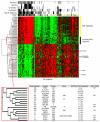Distinct transcriptional MYCN/c-MYC activities are associated with spontaneous regression or malignant progression in neuroblastomas
- PMID: 18851746
- PMCID: PMC2760877
- DOI: 10.1186/gb-2008-9-10-r150
Distinct transcriptional MYCN/c-MYC activities are associated with spontaneous regression or malignant progression in neuroblastomas
Abstract
Background: Amplified MYCN oncogene resulting in deregulated MYCN transcriptional activity is observed in 20% of neuroblastomas and identifies a highly aggressive subtype. In MYCN single-copy neuroblastomas, elevated MYCN mRNA and protein levels are paradoxically associated with a more favorable clinical phenotype, including disseminated tumors that subsequently regress spontaneously (stage 4s-non-amplified). In this study, we asked whether distinct transcriptional MYCN or c-MYC activities are associated with specific neuroblastoma phenotypes.
Results: We defined a core set of direct MYCN/c-MYC target genes by applying gene expression profiling and chromatin immunoprecipitation (ChIP, ChIP-chip) in neuroblastoma cells that allow conditional regulation of MYCN and c-MYC. Their transcript levels were analyzed in 251 primary neuroblastomas. Compared to localized-non-amplified neuroblastomas, MYCN/c-MYC target gene expression gradually increases from stage 4s-non-amplified through stage 4-non-amplified to MYCN amplified tumors. This was associated with MYCN activation in stage 4s-non-amplified and predominantly c-MYC activation in stage 4-non-amplified tumors. A defined set of MYCN/c-MYC target genes was induced in stage 4-non-amplified but not in stage 4s-non-amplified neuroblastomas. In line with this, high expression of a subset of MYCN/c-MYC target genes identifies a patient subtype with poor overall survival independent of the established risk markers amplified MYCN, disease stage, and age at diagnosis.
Conclusions: High MYCN/c-MYC target gene expression is a hallmark of malignant neuroblastoma progression, which is predominantly driven by c-MYC in stage 4-non-amplified tumors. In contrast, moderate MYCN function gain in stage 4s-non-amplified tumors induces only a restricted set of target genes that is still compatible with spontaneous regression.
Figures





References
-
- Schwab M, Westermann F, Hero B, Berthold F. Neuroblastoma: biology and molecular and chromosomal pathology. Lancet Oncol. 2003;4:472–480. - PubMed
-
- Vandesompele J, Baudis M, De Preter K, Van Roy N, Ambros P, Bown N, Brinkschmidt C, Christiansen H, Combaret V, Lastowska M, Nicholson J, O'Meara A, Plantaz D, Stallings R, Brichard B, Broecke C Van den, De Bie S, De Paepe A, Laureys G, Speleman F. Unequivocal delineation of clinicogenetic subgroups and development of a new model for improved outcome prediction in neuroblastoma. J Clin Oncol. 2005;23:2280–2299. - PubMed
-
- Seeger RC, Brodeur GM, Sather H, Dalton A, Siegel SE, Wong KY, Hammond D. Association of multiple copies of the N-myc oncogene with rapid progression of neuroblastomas. N Engl J Med. 1985;313:1111–1116. - PubMed
-
- Schwab M, Varmus HE, Bishop JM. Human N-myc gene contributes to neoplastic transformation of mammalian cells in culture. Nature. 1985;316:160–162. - PubMed
Publication types
MeSH terms
Substances
LinkOut - more resources
Full Text Sources
Other Literature Sources
Medical

